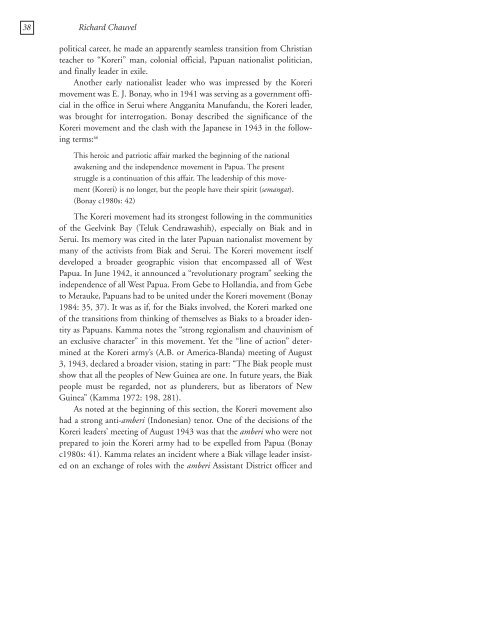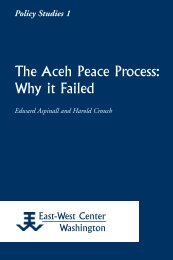Constructing Papuan Nationalism: History, Ethnicity ... - ScholarSpace
Constructing Papuan Nationalism: History, Ethnicity ... - ScholarSpace
Constructing Papuan Nationalism: History, Ethnicity ... - ScholarSpace
- No tags were found...
You also want an ePaper? Increase the reach of your titles
YUMPU automatically turns print PDFs into web optimized ePapers that Google loves.
38 Richard Chauvelpolitical career, he made an apparently seamless transition from Christianteacher to “Koreri” man, colonial official, <strong>Papuan</strong> nationalist politician,and finally leader in exile.Another early nationalist leader who was impressed by the Korerimovement was E. J. Bonay, who in 1941 was serving as a government officialin the office in Serui where Angganita Manufandu, the Koreri leader,was brought for interrogation. Bonay described the significance of theKoreri movement and the clash with the Japanese in 1943 in the followingterms: 66This heroic and patriotic affair marked the beginning of the nationalawakening and the independence movement in Papua. The presentstruggle is a continuation of this affair. The leadership of this movement(Koreri) is no longer, but the people have their spirit (semangat).(Bonay c1980s: 42)The Koreri movement had its strongest following in the communitiesof the Geelvink Bay (Teluk Cendrawashih), especially on Biak and inSerui. Its memory was cited in the later <strong>Papuan</strong> nationalist movement bymany of the activists from Biak and Serui. The Koreri movement itselfdeveloped a broader geographic vision that encompassed all of WestPapua. In June 1942, it announced a “revolutionary program” seeking theindependence of all West Papua. From Gebe to Hollandia, and from Gebeto Merauke, <strong>Papuan</strong>s had to be united under the Koreri movement (Bonay1984: 35, 37). It was as if, for the Biaks involved, the Koreri marked oneof the transitions from thinking of themselves as Biaks to a broader identityas <strong>Papuan</strong>s. Kamma notes the “strong regionalism and chauvinism ofan exclusive character” in this movement. Yet the “line of action” determinedat the Koreri army’s (A.B. or America-Blanda) meeting of August3, 1943, declared a broader vision, stating in part: “The Biak people mustshow that all the peoples of New Guinea are one. In future years, the Biakpeople must be regarded, not as plunderers, but as liberators of NewGuinea” (Kamma 1972: 198, 281).As noted at the beginning of this section, the Koreri movement alsohad a strong anti-amberi (Indonesian) tenor. One of the decisions of theKoreri leaders’ meeting of August 1943 was that the amberi who were notprepared to join the Koreri army had to be expelled from Papua (Bonayc1980s: 41). Kamma relates an incident where a Biak village leader insistedon an exchange of roles with the amberi Assistant District officer and
















